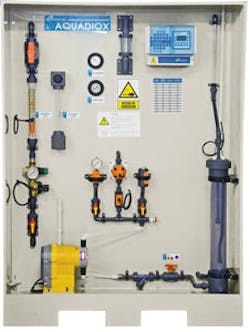Chlorine Dioxide Proves Effective Chlorine Alternative
In November 1988, the European Union published Directive 98/83/EC, which aimed to reduce the formation of disinfection byproducts (DBPs) and set quality standards for drinking water quality at the tap. This directive led, in February 2003, to Spanish legislation in the form of Royal Decree 140/2003, which established a limit on trihalomethanes (THMs) of 100 µg/L in drinking water applications, taking effect on Jan. 1, 2009.
During the transition period of January 2004 to December 2008, the THM limit was set at 150 µg/L. As a result of pending, more stringent regulations, drinking water facilities across Spain began to study, review and implement alternative, non-chlorine based, disinfection treatment alternatives such as chlorine dioxide.
The water and wastewater supply network of the Western Costa del Sol in Spain is owned and managed by ACOSOL, a public water utility that serves the needs of 11 municipalities. The Drinking Water Treatment Station of River Verde receives water from two sources: the La Concepcion reservoir and a desalination plant.
Over a one-year period, 2007 to 2008, ACOSOL monitored the concentration of total THMs in its supply network. At this time, ACOSOL was using gas chlorination as the primary form of disinfection treatment. Nearly 20% of the analyses indicated THM values close to 150 µg/L, and 35% of the analyses indicated values above the proposed new limit of 100 µg/L. The average values of the analyses indicated a THM level of between 103 µg/L and 105.5 µg/L—levels that complied with the transition THM standard in 2008 but would fail to meet the new THM limit that would take effect Jan. 1, 2009.
As a result, ACOSOL entered into a three-part study to identify and implement a disinfection treatment solution that would reduce THM concentrations to comply with the new 100-µg/L limit.
Chlorine Dioxide as Chlorine Replacement
Prior to undertaking the study, three characteristic sampling points were determined:
- The treatment outlet: analysis of water taken from the regulating reservoir, where waters from the treatment station and from the desalination plant were mixed;
- Forest Hill: a 315-cu-meter reservoir serving the utility's western region; and
- Toro III: a 25,000-cu-meter reservoir serving the utility's eastern region.
Phase 1 began in April 2008 and ended prior to December 2008, and it included the introduction of chlorine dioxide as an oxidant/disinfectant to the pre-treatment oxidation stage prior to settlement. Chlorine was still used as the primary disinfectant and dosed to maintain a free residual chlorine level of 1.2 parts per million (ppm), ensuring adequate disinfection at the point of supply. The introduction of chlorine dioxide at this stage reduced the precursors of THMs by up to 30%. Results showed a decrease in the formation of THMs at the treatment outlet since chlorine was not injected during pre-treatment and the contact time of disinfectant chlorine in the treatment station was reduced compared to when chlorine was used as the sole disinfectant.
However, in the supply network, the chlorine precursors' contact time remained the same as under previous conditions, resulting in higher levels of THMs formed than at the treatment station outlet.
Phase 2 began in December 2008, ended in March 2009 and included the introduction of chlorine dioxide into the distribution network as chlorine was gradually withdrawn. There were periods of instability in the system as adjustments were made during the four months to achieve the proper dosing requirements of chlorine dioxide for disinfection and residual maintenance in the supply network. Chlorine dioxide doses were increased from 0.3 ppm to 0.7 ppm with an accompanying chlorine adjustment up to 1 ppm.
Once the demand for chlorine dioxide in the distribution network had been exceeded, chlorine dioxide doses were reduced to 0.5 ppm. When the chlorine dioxide had been exceeded and stabilization had been achieved in the presence of chlorine dioxide in the network, a significant reduction in total THMs was observed compared to the use of chlorine only. The reduction was estimated at greater than 90% at the treatment station outlet and 80% in the distribution network. In all cases, the THM values were at a maximum of 30 µg/L. In addition to lowering THM values, the increased chlorine dioxide dosing enabled a pH reduction from a range of 8.1 to 8.3 to a value of 7.5.
Phase 3 began in April 2009 and ended in August 2009. It included the introduction of a constant and stable dosing of chlorine dioxide at 0.3 ppm accompanied by chlorine up to 1 ppm. The use of chlorine dioxide continued both in oxidation/pre-treatment and in disinfection so that a residual amount was obtained at all points of the supply network. THM formation from June to August reached a high of approximately 30 µg/L. It was also determined that the dosing of chlorine dioxide in disinfection facilitated a reduction in the concentration of disinfectant in the network. At the treatment station outlet, the combined concentration of chlorine dioxide and chlorine was 1 ppm, compared with a concentration of 1.2 ppm of chlorine that was previously necessary in order to ensure the existence of disinfectant at the end of the network.
The use of chlorine dioxide as a disinfectant resulted in chlorite and chlorate byproducts at a maximum proportion of 60% and 30%, respectively. The residual chlorite value at any moment throughout the process was determined to be below the legislatively mandated value. Only when the dosage of chlorine dioxide exceeded 1.1 ppm did values of sodium chlorite approach the legislated value of 0.7 ppm.
Results
Using chlorine dioxide as a disinfectant, ACOSOL complied with Spanish and European THM standards and could even comply with the standards of more demanding countries, where legislation for a maximum level of total THMs is 30 µg/L.
